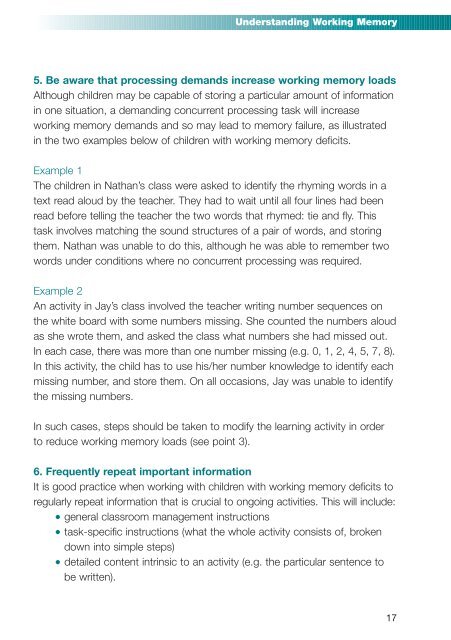Classroom guide
Classroom guide
Classroom guide
You also want an ePaper? Increase the reach of your titles
YUMPU automatically turns print PDFs into web optimized ePapers that Google loves.
Understanding Working Memory<br />
5. Be aware that processing demands increase working memory loads<br />
Although children may be capable of storing a particular amount of information<br />
in one situation, a demanding concurrent processing task will increase<br />
working memory demands and so may lead to memory failure, as illustrated<br />
in the two examples below of children with working memory deficits.<br />
Example 1<br />
The children in Nathan’s class were asked to identify the rhyming words in a<br />
text read aloud by the teacher. They had to wait until all four lines had been<br />
read before telling the teacher the two words that rhymed: tie and fly. This<br />
task involves matching the sound structures of a pair of words, and storing<br />
them. Nathan was unable to do this, although he was able to remember two<br />
words under conditions where no concurrent processing was required.<br />
Example 2<br />
An activity in Jay’s class involved the teacher writing number sequences on<br />
the white board with some numbers missing. She counted the numbers aloud<br />
as she wrote them, and asked the class what numbers she had missed out.<br />
In each case, there was more than one number missing (e.g. 0, 1, 2, 4, 5, 7, 8).<br />
In this activity, the child has to use his/her number knowledge to identify each<br />
missing number, and store them. On all occasions, Jay was unable to identify<br />
the missing numbers.<br />
In such cases, steps should be taken to modify the learning activity in order<br />
to reduce working memory loads (see point 3).<br />
6. Frequently repeat important information<br />
It is good practice when working with children with working memory deficits to<br />
regularly repeat information that is crucial to ongoing activities. This will include:<br />
• general classroom management instructions<br />
• task-specific instructions (what the whole activity consists of, broken<br />
down into simple steps)<br />
• detailed content intrinsic to an activity (e.g. the particular sentence to<br />
be written).<br />
17



